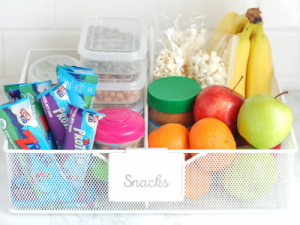 Most parents complain that their teens are eating them “out of house and home” as the growth spurts of this age can drive teens to eat far more than an average adult. But what if your teen is a reluctant eater? What if they have ADHD and forget to eat? Or Sensory Processing Disorder and many foods are unappealing? You can find yourself worried your teen is underweight or even dealing with an eating disorder.
Most parents complain that their teens are eating them “out of house and home” as the growth spurts of this age can drive teens to eat far more than an average adult. But what if your teen is a reluctant eater? What if they have ADHD and forget to eat? Or Sensory Processing Disorder and many foods are unappealing? You can find yourself worried your teen is underweight or even dealing with an eating disorder.
Goal number one is to make food easy and appealing. Teens don’t generally want to roll out of bed and start cooking. They just don’t feel the drive to start their day with a chore. So, foods need to be readily available.
Snack Stations
For kids with ADHD who just forget to eat, hiding the food in pantries and cabinets can make choosing a snack harder than it should be. For this reason, setting up a snack station can really help. you can use your chip and dip set that lives in the back of your pantry, or the veggie tray you never use. Select a variety of snacks your child eats and arrange them in an appealing manner. Be sure to put them in an easy-to-see and easy-to-access place, like your kitchen table or counter.
 Our snack station holds some granola bars and breakfast bars. It has a few treats, mini candy bars, or small chocolates in wrappers. It also has some cups of apple sauce and whole apples. I have 3 teens who drop by the station to select snacks and they all have different needs. I try to make sure all the snacks are safe for everyone’s food allergies. Adding the snack space to the grocery list is an important addition.
Our snack station holds some granola bars and breakfast bars. It has a few treats, mini candy bars, or small chocolates in wrappers. It also has some cups of apple sauce and whole apples. I have 3 teens who drop by the station to select snacks and they all have different needs. I try to make sure all the snacks are safe for everyone’s food allergies. Adding the snack space to the grocery list is an important addition.
You can also create a snack space in your refrigerator. Small clear bins can hold yogurt cups, individual cheeses (my kids love Babybel), fruit, or baby carrots. Consider putting berries, grapes, or cut-up vegetables into small containers that can easily be grabbed for snacking.
Baking
 While teens may turn up their noses at your cooking, most of them love treats. I’m a fan of being a sneaky chef and adding nutrients where I can. I also like to bake with nutrition in mind. Baked oatmeal is naturally full of whole grains and you can bump up the nutrition by adding a spoonful of ground flax seeds. I bake brownies for my kids and use coconut oil to make sure they are getting good fats in their diet. Brownies also are a good place to hide ground flax seeds, ground black beans, or purred blueberries. With a little research, you can find lots of recipe ideas to test out.
While teens may turn up their noses at your cooking, most of them love treats. I’m a fan of being a sneaky chef and adding nutrients where I can. I also like to bake with nutrition in mind. Baked oatmeal is naturally full of whole grains and you can bump up the nutrition by adding a spoonful of ground flax seeds. I bake brownies for my kids and use coconut oil to make sure they are getting good fats in their diet. Brownies also are a good place to hide ground flax seeds, ground black beans, or purred blueberries. With a little research, you can find lots of recipe ideas to test out.
Serve Family Meals
It can be hard to force yourself to cook when your kids or teens don’t want to eat, but it is important. Family-style meals can introduce more foods and diet diversity kids need. Serve at least one food your child likes alongside other foods. Meals like a taco bar, where everyone chooses their own toppings can make your own meal more interesting. It also can help your child to see and smell different foods than they typically choose. Even if they still just have the same plain option they always eat.
Eating together can make food more enjoyable. Try having topics of conversation ready or bring out a quiz game to play while you eat. Consider asking everyone to answer open-ended questions like “What animal would you like to be?” This can spur a fun family conversation. Topics like what you did today or the news can be too stressful for sensitive kids.
Education
If your child isn’t eating enough, spend some time educating them. Our culture is obsessed with food and calories. You can find websites with pictures of what you should eat each day for a range of calorie intakes. Be sure you are starting with a healthy calorie goal for your child. Then show them what that many calories a day actually looks like.
 Encourage your child to eat a full range of foods, especially carbs. Our diet culture has made carbs the bad guy, but we really need them to survive. Our bodies turn grains and carbohydrate foods like potatoes, into energy. We need that energy to move, work, play, and think. We need proteins like meats and beans to build muscles. Fruits and vegetables give us nutrients needed for our immune systems to function. Fats like butter and nuts are necessary for brain function. Importantly though, don’t make judgments about foods being “bad.” A healthy diet can include treats and junk food in moderation. Eating all things in moderation is proven to lead to healthier lifelong eating than limiting or forcing foods on a child.
Encourage your child to eat a full range of foods, especially carbs. Our diet culture has made carbs the bad guy, but we really need them to survive. Our bodies turn grains and carbohydrate foods like potatoes, into energy. We need that energy to move, work, play, and think. We need proteins like meats and beans to build muscles. Fruits and vegetables give us nutrients needed for our immune systems to function. Fats like butter and nuts are necessary for brain function. Importantly though, don’t make judgments about foods being “bad.” A healthy diet can include treats and junk food in moderation. Eating all things in moderation is proven to lead to healthier lifelong eating than limiting or forcing foods on a child.
What if they just won’t eat?
If your child just won’t eat, seek help. Therapists, nutritionists, and doctors can help you find resources to help your child be at a healthy weight. Keep trying. Don’t give up. Parenting teens can be just as challenging as parenting toddlers. So, be kind to yourself and to them.





0 Comments